There are 23 companion plants for Cherry trees in this list including vegetables, flowers, herbs, and of course other fruit trees.
Cherry trees are highly regarded fruit-bearing plants that flourish in various garden settings. A diverse choice of plants may complement cherry trees’ magnificent beauty and production regarding companion planting. Examples of partners include vegetables, fruits, herbs, flowers, ornamental grasses, alliums, succulents, climbing plants, trees, and shrubs.
Cherry trees, for example, work well with specific veggies such as garlic, onions, lettuce, and radishes. Strawberries, raspberries, and blueberries are ideal partners, improving appearance and pollination. Herbs with fragrant properties, such as chamomile, dill, parsley, and chives, give a great sensory experience to the garden. Flowers such as marigolds, nasturtiums, and calendula look nice and attract pollinators.
The presence of decorative grasses, alliums, succulents, climbing plants, apple, and peach trees, and bushes such as gooseberries and currants improves the environment surrounding cherry trees.
By carefully selecting and growing these complementary companions, you may build a lively and healthy landscape that maximizes the beauty, production, and general health of your treasured cherry trees.
In this article, we will talk about Twenty – Three Good Companion plants and Bad Companion plants for Cherry trees and why they should be planted with or not planted with it.
Table of Contents
Good Companion Plants for Cherry Trees
Vegetables
1. Garlic
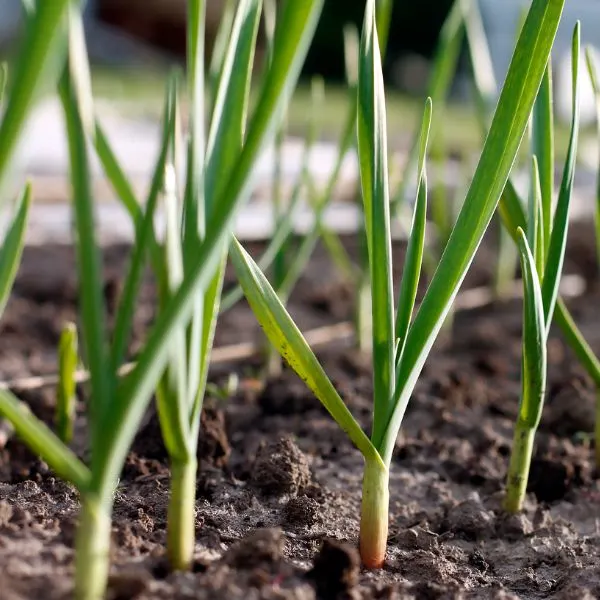
Garlic adds a plethora of advantages to your cherry tree garden, producing a dynamic and harmonious atmosphere. Garlic, with its enticing perfume and powerful character, is a formidable partner to cherry trees, providing a delicious synergy that improves both visual appeal and general plant health.
Garlic’s natural capacity to repel pests and insects is one of its surprising benefits, offering an organic defense mechanism for fragile cherry trees. Garlic’s strong components, particularly allicin, have great antibacterial and antifungal capabilities, which help protect cherry trees from common illnesses.
Furthermore, the subterranean root structure of garlic supplements the superficial roots of cherry trees, increasing soil stability and reducing erosion. This dynamic collaboration improves nutrient absorption and provides a balanced habitat in which both plants can thrive.
While growing garlic alongside cherry trees has several advantages, examining garlic’s growth patterns is vital since it can compete for resources if not properly maintained. Keeping a safe distance from the tree’s drip line and using companion planting strategies like intercropping or raised beds will help alleviate any possible issues.
Garlic not only offers gastronomic delights to your cherry tree garden but also builds a healthy and vibrant environment in which both species may thrive peacefully.
2. Onions
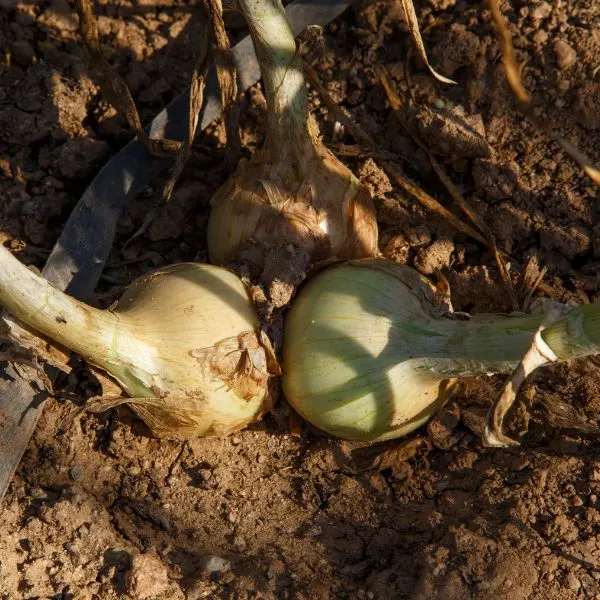
With their strong aroma and complex character, onions emanate a bright vitality that energizes cherry trees. Their extensive root systems, like underground explorers, penetrate deep into the soil, boosting structure and nutrient availability. The cherry tree is nurtured by this dynamic subsurface teamwork, which promotes vigorous development and abundant harvests.
The fascination, however, continues further. With their fragrant defensive mechanisms, onions naturally repel pests, warding off the invasive forces that endanger the cherry tree’s life. Their allium essence forms a fragrant screen, protecting against dangerous insects and preventing disease spread.
However, a delicate balance must be established. Onions’ rapid growth might compete for resources, demanding careful spacing and watering. Furthermore, choosing appropriate onion kinds that match the growth pattern of the cherry tree promotes peaceful coexistence.
Remember to leave enough room for both entities to thrive in this fascinating alliance, generating an environment brimming with life and rich harvests. Accept this intriguing combination of onion and a cherry tree, and watch a mesmerizing symphony of flavours and aesthetics emerge in your yard.
3. Lettuce
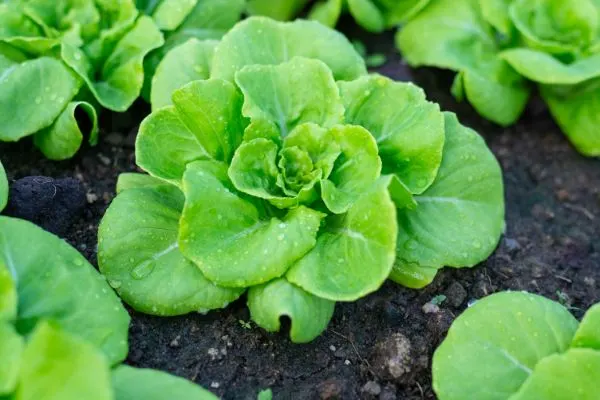
The brilliant marriage of lettuce and cherry trees yields a slew of benefits. Lettuce functions as a natural ground cover, shielding the soil underneath it. The soil keeps moisture while shielded from the sun’s unrelenting beams, keeping the cherry tree’s roots well-hydrated over the blistering summer months. This moisture retention eliminates the time-consuming job of continuous watering, promoting water-wise practices.
Furthermore, lettuce’s shallow root system complements rather than competes for valuable nutrients and water with the cherry tree’s wide network. This symbiotic dance guarantees that both plants flourish and expand to their full potential.
A fine balance, however, must be established. The quick growth of lettuce might block sunlight from reaching new cherry trees. Prudent spacing and occasional trimming alleviate this overshadowing problem, maintaining the tree’s healthy growth.
Choose lettuce kinds that prefer partial shade, balancing their demand for sunshine with the shade given by the cherry tree’s beautiful canopy. A thick layer of organic mulch applied around the base of the tree feeds the soil while prohibiting weeds from invading this healthy alliance.
4. Radishes

Radishes serve as friendly companions in this intriguing collaboration, tirelessly warding off any predators. Their strong perfume functions as a natural deterrent, successfully repelling insects and deterring pests that may attack cherry trees.
Furthermore, radishes serve as watchful sentinels, warning of impending perils. Their vulnerability to some diseases acts as an early warning system, allowing gardeners to take preventative steps to save the prized cherry trees.
However, handling the specific hurdles that this collaboration presents is critical. Radishes are voracious growers who want room and nourishment. Adequate spacing and vigilant monitoring are critical to preventing resource competition and ensuring both crops flourish in harmony.
Furthermore, time is critical. Sow radish seeds a few weeks before planting cherry trees to allow them to establish themselves without intruding on the delicate roots of the young tree.
Adopt these recommended practices to achieve maximum results. Choose radish kinds that mature quickly, in sync with the growth cycle of the cherry tree. Prioritize consistent soil hydration and weed management to ensure that both plants develop continuously.
By using these approaches consistently, you’ll see a symphony of tastes and colours—bright cherries above and a brilliant tapestry of radishes underneath, producing a gorgeous vision of wealth and life.
Fruits
5. Strawberries
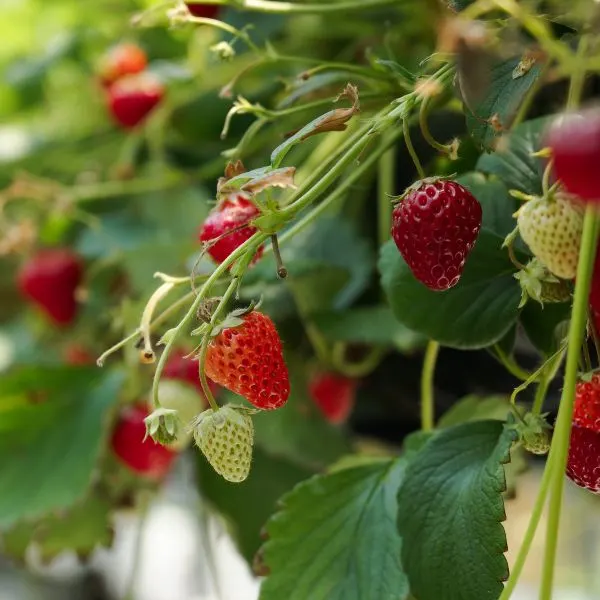
Strawberries, with their rich crimson fruits, provide a plethora of benefits to cherry trees. Their low-growing nature generates a lovely ground cover that protects the soil from erosion while minimizing weed competition, which might hinder cherry tree development. This live mulch also helps to control soil moisture and temperature, creating an ideal habitat for both crops.
However, the synergy continues! Strawberries serve as live sentinels, attracting beneficial insects to your yard. Attracted by the delicate petals of the strawberries, these pollinators painstakingly travel between flowers, increasing the cherry tree’s pollination success and, eventually, fruit output.
Furthermore, the strawberries’ shallow root system complements the deeper root network of the cherry tree, reducing direct competition for nutrients and water. This cooperative dance allows both plants to grow beside one another without jeopardizing their own health and vitality.
Consider strawberry kinds that compliment the cherry tree’s growth patterns, and sunshine needs for maximum results. It is critical to provide proper spacing and regular watering for both crops in order to promote vigorous development and abundant harvests. Regular pest and disease monitoring will aid in the preservation of a healthy ecosystem.
Strawberry and cherry tree planting capture the essence of a beneficial relationship, weaving beauty, practicality, and gastronomic delights into your garden tapestry. Accept this dynamic collaboration and enjoy the benefits it bestows on your environment with its plentiful, vivid, and harmonious attractiveness.
6. Raspberries
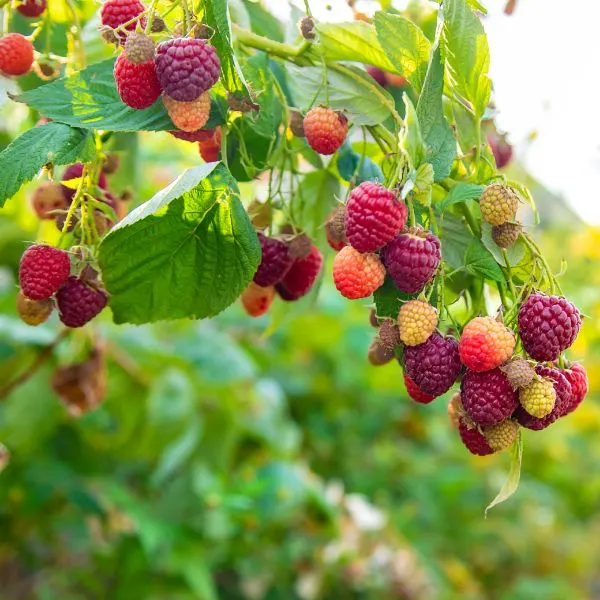
Raspberries, with their colourful appearance, are lovely partners to cherry trees. Their roots penetrate the soil, improving soil structure and nutrient retention while also acting as a protective barrier against erosion. As these enticing berries grow, they attract pollinators such as bees and butterflies, energizing the cherry blossoms with a frenzy of activity.
The synergistic relationship between raspberries and cherry trees goes beyond appearances. Raspberries act as a natural shade cover, sheltering the soil beneath the cherry tree from intense sunlight and fostering stronger root systems. Their tiny canes weave a tapestry of support, bolstering the cherry tree’s branches during strong winds and protecting the fruit-laden limbs from injury.
While this collaboration offers several benefits, difficulties may occur. Both raspberries and cherry trees require well-drained soil and careful water management to avoid waterlogging. Pruning must be done methodically to guarantee optimal development and avoid congestion.
Allow enough space between the two crops to allow for appropriate air circulation and to reduce the danger of disease transmission. Organic mulch will help in moisture retention and weed suppression, allowing both crops to thrive in harmony.
7. Blueberries

Blueberries, for starters, are helpful partners, nourishing the soil with their propensity for acidic conditions. Their tiny roots weave through the soil, increasing nutrient intake while honoring the cherry tree’s requirement for a pH balance; this collaborative dance promotes overall soil health and enhances both plants’ resistance to environmental stresses.
Furthermore, the interaction between their root systems demonstrates an inventive use of vertical space. The deep-reaching roots of the cherry tree easily tap into subterranean water sources, but the shallow-rooted blueberries thrive in the sunlight at top levels. This vertical integration optimizes resource allocation by reducing rivalry and maximizing the utilization of available nutrients and water.
While luscious cherries entice our taste senses, blueberries are an enticing pull for pollinators. Their delicate flowers, which bees and other helpful insects love, create a thriving environment in your orchard. Increased pollination rates increase fruit sets for cherry and blueberry crops, resulting in abundant harvests.
Nonetheless, there are a few points to consider. Because blueberries are more sensitive to soil conditions, they may require extra amendments to suit their specific nutritional requirements. Adapting to this demand allows optimal growth and a pleasant relationship with the cherry tree.
To achieve successful cohabitation, give enough space between plants to allow for sufficient air circulation and access to sunshine. Regular pest and disease monitoring assures early action and the collective well-being of this thriving couple.
Finally, interweaving blueberries and cherry bushes open up a world of possibilities. Their complementing traits result in improved soil health, more efficient resource management, higher pollination rates, and a beautiful orchard brimming with nature’s dynamic vitality. Accept this enticing partnership and luxuriate in the rich benefits it gives.
Herbs
8. Chamomile
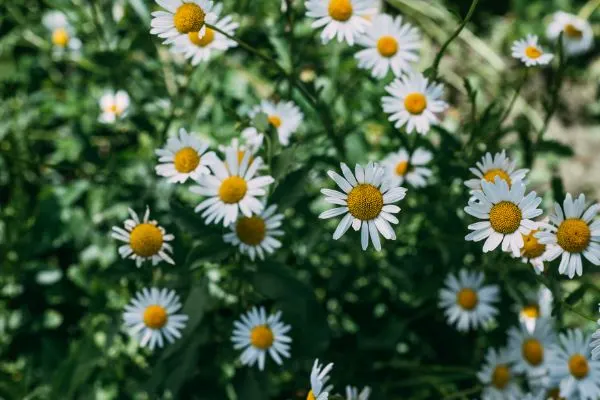
Chamomile, with its exquisite daisy-like blossoms and enticing aroma, adds more to the table than simply visual charm. This fragrant plant is a potent ally, improving cherry trees’ general health and vitality.
Chamomile’s numerous benefits are the source of its unexpected complexity. Chamomile is a natural pest repellent, deterring troublesome insects that may injure cherries. Its fragrant chemicals provide a relaxing perfume that not only pleases the senses but also deters unwanted pests.
Furthermore, the vast root system of chamomile functions as an excellent soil improver, increasing nutrient availability and water retention. Its deep-reaching roots break up compacted soil, allowing oxygen and water to reach the cherry tree’s roots.
However, regulating chamomile’s fast development is a possible difficulty. Regular trimming and upkeep are required to keep it from overshadowing or competing for resources with the cherry tree.
Consider the following guidelines for maximum success: interplant chamomile near cherry trees, allowing appropriate spacing for both to grow. Embrace the seductive charm of chamomile by gathering its blooms for calming herbal beverages or using them as a natural mulch to aid moisture retention and weed suppression.
Finally, the symbiotic link between chamomile and cherry trees reveals an enthralling collaboration. Chamomile’s fragrance guardian and soil ally qualities blend nicely with the towering cherry, producing a bright and captivating garden tapestry.
9. Dill
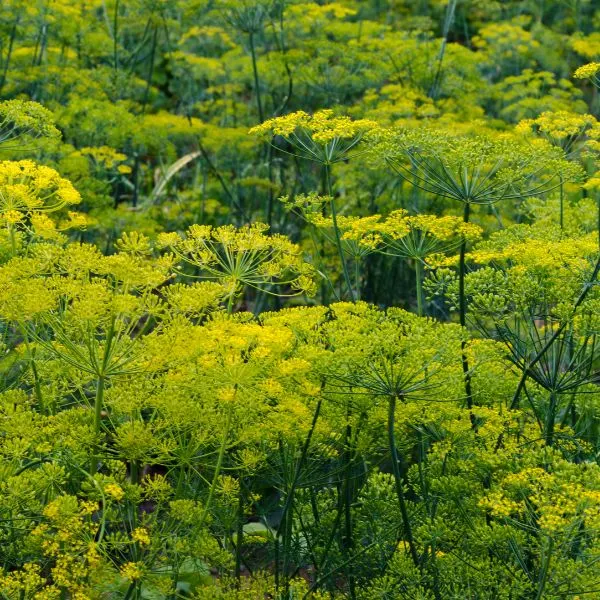
With its vivid fronds and enticing aroma, Dill is dynamically releasing a rich arsenal of benefits on your cherry orchard.
First, the lacy leaves of dill attract a swarm of helpful insects, such as hoverflies and parasitic wasps, who fight an unceasing assault on the nefarious cherry tree pests. These natural soldiers guard the fragile cherry blossoms, assuring a bumper crop.
Furthermore, dill roots collaborate with cherry tree roots to improve soil health through nitrogen fixation, offering a nutritional boost to the overall ecosystem.
While this collaboration brings new issues, such as possible competition for nutrients and space, proper planning and spacing can alleviate these concerns. Dill seeds should be planted in well-drained soil with plenty of sunshine and irrigation. Pruning the flower heads of dill before they develop avoids self-seeding and overpopulation.
You may create an amazing oasis brimming with biodiversity and harmonious growth by supporting this dynamic dance between dill and cherry trees. As dill and cherry trees join forces, they create an incredible tapestry of beauty and plenty in your landscape.
10. Parsley
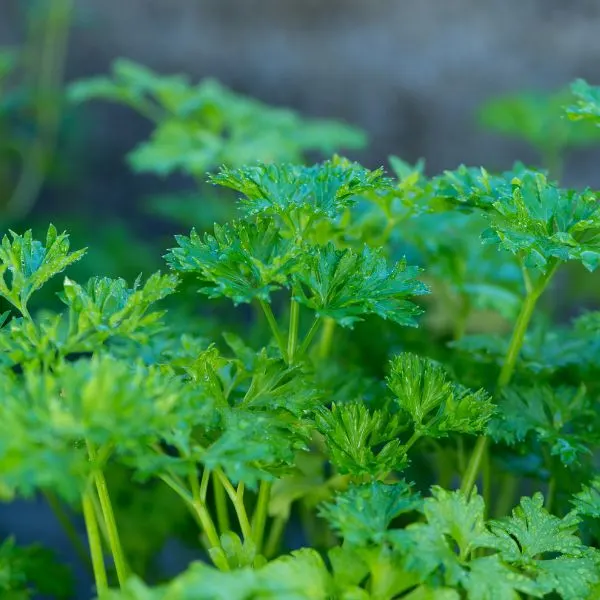
parsley is an excellent companion for cherry trees, improving their general health and vitality. Its rich molecular composition releases a symphony of advantages, enthralling both the grower and the discriminating palate.
Parsley is a natural insect repellent, repelling invaders and safeguarding delicate cherry blossoms. Its pungent flavour confuses insect enemies, protecting the valuable cherries. Furthermore, the deep-rooted nature of parsley improves soil structure, enhancing nutrient absorption and water retention and creating an environment favourable for cherry tree growth.
Planting these two crops together introduces a new challenge: parsley’s proclivity to compete for resources. Strategic spacing and attentive upkeep are required To achieve maximum success.
To achieve a peaceful balance, strategically put parsley plants, leaving enough room for both crops to thrive. Regular trimming and soil amendments make cohabitation possible, allowing cherry trees and parsley to coexist.
11. Chives
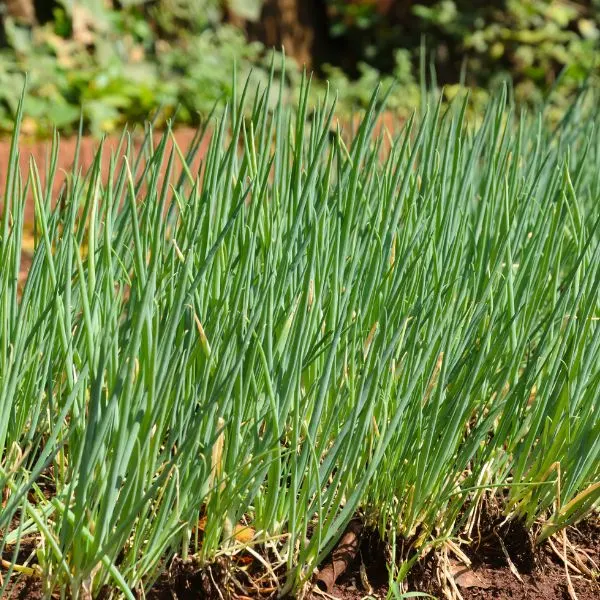
With their brilliant green stems and lovely lavender blooms, chives serve as staunch protectors, repelling intruders from the cherry tree territory. Their spicy perfume consistently repels pests, preventing aphids and slowing the spread of fungal diseases.
Their contributions, however, do not stop there! Chives have a hidden aptitude for enticing pollinators, arranging a bustling ballet of bees and butterflies while increasing cherry tree fruit set and production.
Their large root system improves soil structure and nutrient availability, ensuring the cherry tree’s roots dance in a nutrient-rich symphony.
To establish peaceful cohabitation, keep chives at a respectful distance from each other, leaving enough area for each to grow. Accept the enchantment of cherry trees and chives, and watch nature’s duet unfold with magnificent splendour.
Flowers
12. Marigolds
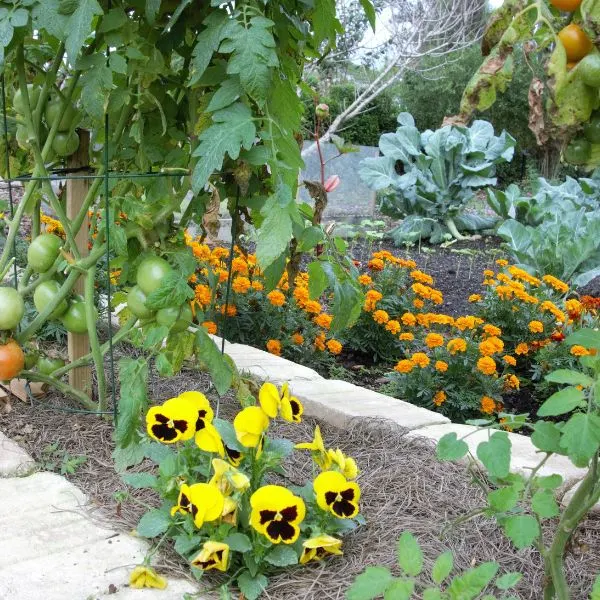
Marigolds are natural pest repellents, aggressively repelling damaging insects that endanger the abundant fruits of Cherry trees. Their root secretions are nematode-resistant, providing a protective layer to the soil.
Furthermore, Marigolds attract useful pollinators, creating a symphony of buzz and flutter, improving Cherry tree pollination, and increasing fruit harvest. This symbiotic relationship results in an aesthetically pleasing and environmentally balanced ecosystem.
However, a word of caution: provide appropriate space between plants since marigolds have allelopathic tendencies that might inhibit the development of surrounding plants.
To maximize this partnership, embrace variety by combining different Marigold cultivars, increasing the aesthetic spectacle while boosting their combined advantages.
Embrace this marriage of bold beauty and botanical power to build a healthy ecology beneath the towering canopy of the Cherry tree.
13. Nasturtiums
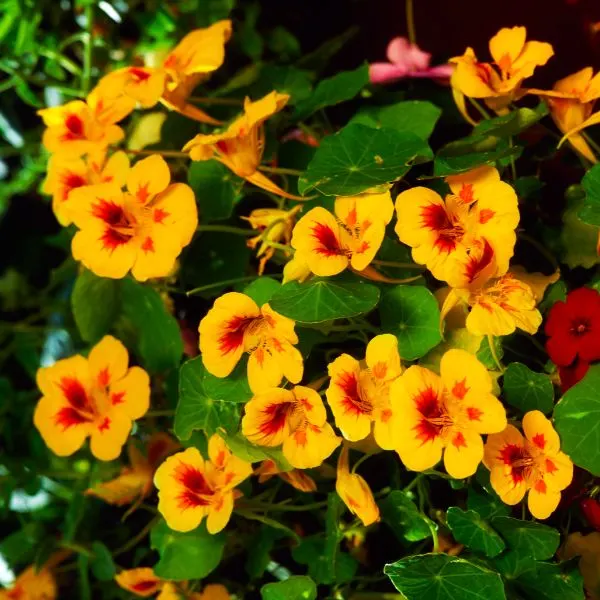
Nasturtiums and cherry trees are a powerful garden combo that provides many enticing benefits. These brilliant and enthusiastic blossoms have an amazing ability to stimulate cherry tree development while also capturing the eye with their vibrant blooms.
Their various contributions hold the key. Nasturtiums are bold defenders, deterring harmful pests with their strong aroma and protecting the cherry tree’s delicate leaves.
Meanwhile, their spreading nature functions as living mulch, controlling invasive weeds and conserving valuable soil moisture, resulting in a harmonic environment for the cherry tree’s roots to thrive.
Furthermore, their inherent climbing proclivity creates an enthralling vertical show, covering the cherry tree’s branches with cascades of bright colors.
To ensure maximum success, give these companion plants well-drained soil, plenty of sunshine, and enough space to develop. Embrace the symbiotic link that exists between nasturtiums and cherry trees to create a garden synergy that tantalizes the senses and fosters rich beauty.
14. Calendula
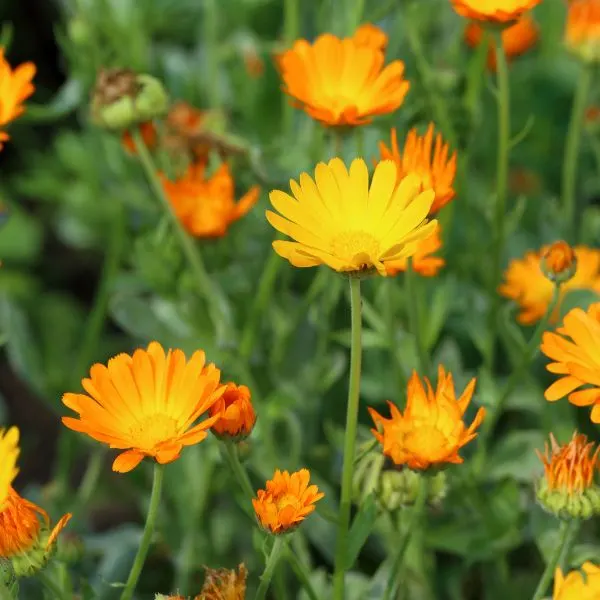
With its enticing golden blooms, Calendula attracts helpful insects such as ladybugs and lacewings, who gladly feast on cherry tree pests. These brilliant buddies provide natural pest control, devotedly defending your cherries.
Furthermore, the deep taproots of calendula help in soil aeration and nutrient uptake, creating a healthy ecology for cherry tree roots to explore. The dynamic interaction of these botanical allies promotes pollination, resulting in abundant cherry harvests with increased taste qualities.
While their collaboration is certainly pleasant, keep an eye on Calendula’s enthusiasm since it may overwhelm the cherry tree’s lower branches if left unchecked. Pruning and clever positioning can help to alleviate this worry while still allowing you to appreciate the kaleidoscope looks.
Allow the fascinating waltz of Calendula and Cherry trees to take your landscape to spectacular heights by embracing the beauty of this botanical combination.
Ornamental grasses
15. Feather reed grass
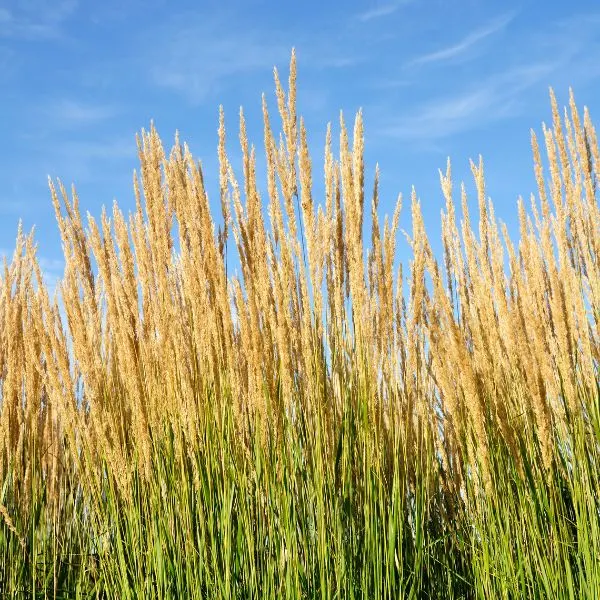
The combination of feather reed grass (Calamagrostis acutiflora) and cherry trees captivates the senses while boosting the entire scene. The beautiful, feathery plumes of the grass dance in perfect beat beside the brilliant cherry blossoms in this dynamic duo’s symphony of visual harmony.
The advantages of growing Feather reed grass go beyond looks. Its deep root system improves soil structure and moisture retention, providing cherry plants with a loving environment. The grass works as a living mulch, decreasing weed competition and root zone temperature swings.
Embracing this mix has its own set of benefits and drawbacks. While the erect structure of Feather reed grass adds beauty, it requires occasional trimming to avoid overshadowing the cherry tree. Ensuring appropriate space between them provides optimal air circulation, reducing the risk of illness.
Plant Feather reed grass and cherry trees in well-drained soil with plenty of sunshine for best results. Watering on a regular basis, especially during the establishing phase, promotes strong development. Accept this enticing union in which the smooth swing of grass and the beauty of cherry trees mix to create a really stunning landscape sight.
16. Switchgrass
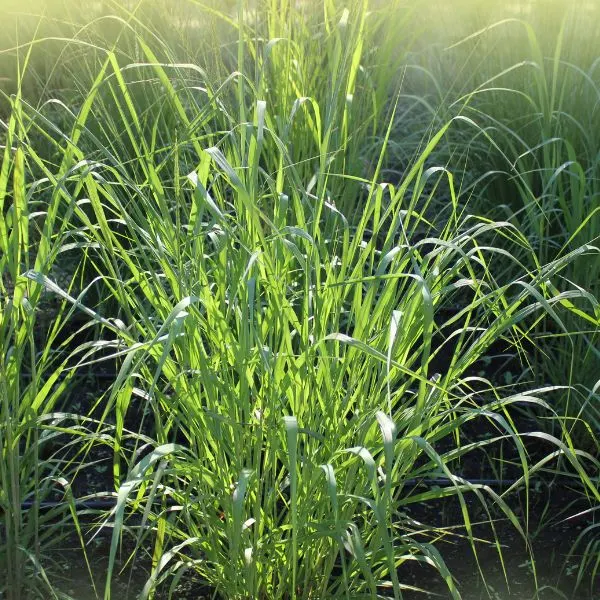
With its hardy roots and towering size, switchgrass serves as a fortress, protecting the cherry trees from wind damage and erosion. Its deep-rooted nature improves soil structure, boosting water penetration and nutrient retention, resulting in healthier, more robust cherry plants.
Furthermore, switchgrass offers a fascinating visual appeal, with its fluffy plumes fluttering in the breeze and complimenting the delicate petals of the cherry tree. The interwoven leaves create a harmonic tapestry that provides shade to the soil reduces weed competition, and conserves moisture.
However, adequate spacing must be established to avoid resource competition, and switchgrass must be pruned consistently to preserve balance. Accept this botanical partnership and cultivate a stunning and durable environment where cherry trees and switchgrass live in wonderful harmony.
Succulents
17. Sedum
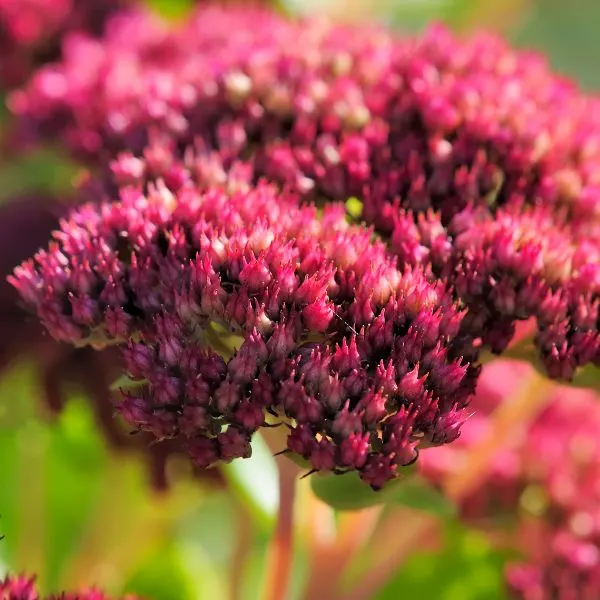
Sedum works as a living mulch, producing a protective screen against weeds and soil erosion while saving moisture with its fleshy leaves, making it a water-wise partner for the thirst-quenching Cherry trees.
Its ground-hugging habit functions as a living carpet, improving the microclimate surrounding the tree’s base, protecting it from severe temperatures, and providing an insulating embrace.
Furthermore, the nectar-rich flowers of Sedum attract a symphony of buzzing allies to ensure maximum Cherry tree pollination. However, extreme competition for nutrients and space must be avoided.
Plant Sedum somewhat away from the Cherry tree trunk to obtain the highest level of success, allowing adequate breathing space for both partners. Accept this couple and see a lovely dance of colours, hardiness, and rich harvests.
Climbing plants
18. Clematis
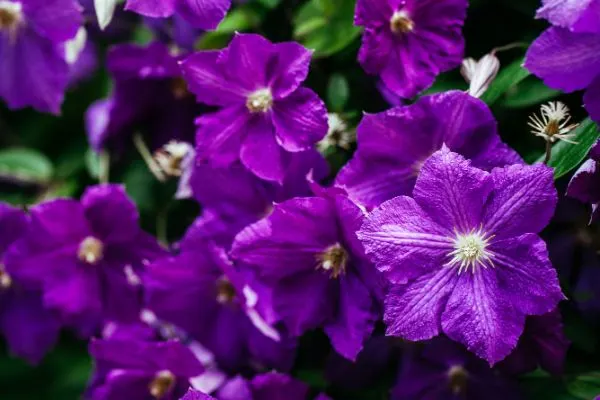
Clematis’ exuberant nature, with its brilliant blossoms and delicate tendrils, gently intertwines with Cherry trees’ regal size, producing a beautiful symphony of drama and beauty.
Beyond their visual complementary, Clematis provides several advantages to its Cherry tree mate. Its spreading growth style functions as a living mulch, protecting the soil from overheating and preventing moisture loss. This protective embrace protects Cherry trees’ shallow root structure, increasing their resistance during dry seasons and fostering healthy development.
While this dynamic coupling provides several benefits, some problems must be addressed. Competing for nutrients and moisture is possible, requiring careful pruning and strategic positioning to maintain a harmonic equilibrium. Provide substantial trellising or support structures for Clematis to avoid crowding the Cherry tree limbs.
Choose Clematis cultivars that grow in comparable light and soil conditions as Cherry trees for the best results. Watering, mulching, and fertilizing on a regular basis will maintain this enticing collaboration, resulting in a garden tapestry that captivates the imagination and lures nature lovers.
19. Grapevines

The benefits of this combo are numerous. Grapevines act as a natural trellis for cherry tree branches, promoting development and making the most of available space. This symbiotic connection boosts pollination rates, resulting in plentiful cherry harvests.
Furthermore, the spreading grape leaves provide critical shade, shielding the fragile cherry blossoms from the hot summer sun. The exchange of nutrients in the soil is improved, benefiting both plants’ general health.
However, it is critical to address any issues. Pruning procedures should be methodically executed to preserve balance and avoid overshadowing. Careful disease and pest monitoring are required, To reduce any hazards that may harm both crops.
To achieve maximum success, provide enough ventilation and choose a grapevine type compatible with the cherry tree’s growth patterns. These rich beauties work together to create a garden spectacle, producing a harvest of tastes while dazzling with their interlaced elegance.
Trees
20. Apple trees
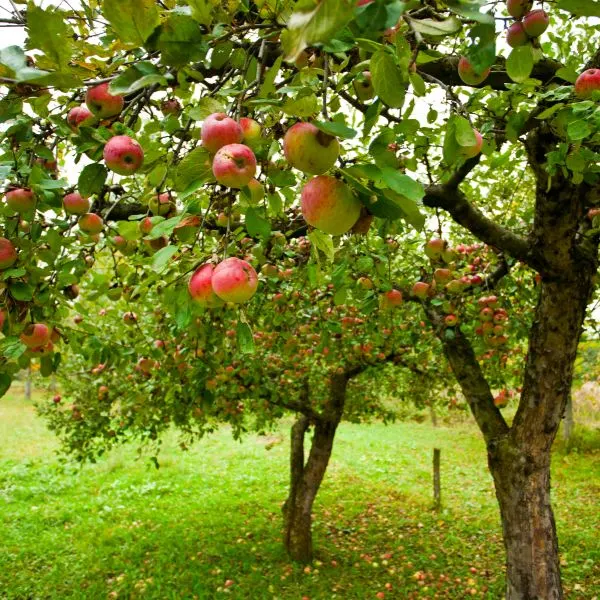
Planting Apple and Cherry trees together creates a dynamic and mutually beneficial partnership. These arboreal friends constitute a strong combination in your orchard, improving both visual appeal and total yield. Their harmonic presence fosters a biodiversity symphony, attracting a varied variety of pollinators and assuring prolific fruit sets and better yields.
The distinct benefit is that Apple trees bloom slightly later than Cherries, lowering the chance of frost damage. This synchronization improves cross-pollination, producing delicious and succulent fruits with increased size, taste, and juiciness.
However, it is critical to address any issues. Appropriate spacing is critical to avoid competition for nutrients and sunshine, as both trees may develop rapidly. Regular trimming and good care are required to regulate canopy growth and guarantee optimum air circulation, which reduces disease risk.
Choose suitable Apple types, such as ones with overlapping bloom periods, for the best results. Consider your region’s special requirements, seek local experts, and revel in the beautiful marriage of Apple and Cherry trees, an exceptional alliance flowering with unlimited benefits.
21. Peach trees
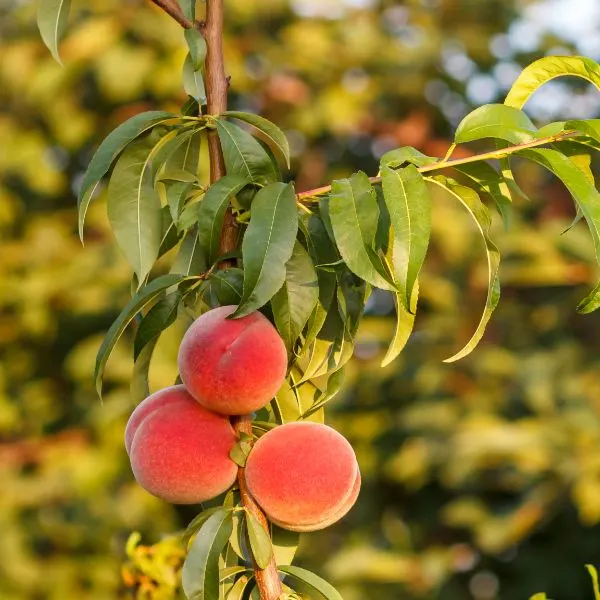
Planting Peach trees beside Cherry trees creates a colourful and dynamic garden combination. These two fruit-bearing powerhouses create this wonderful symphony of tastes and benefits.
Peach plants add a splash of sweet juiciness to the acidity of Cherry trees with their beautiful, velvety fruits. They combine to produce a delightful symphony of flavors for your palette to enjoy.
The combination of Peach and Cherry trees is more than just a gastronomic treat. These partners have comparable development needs and may coexist in the same habitat. They both thrive in full sun, well-drained soil, and good air circulation. Their proximity can boost pollination, producing more fruit output for both species.
However, one must keep in mind the possible difficulty of dealing with pests and illnesses that can harm both Peach and Cherry plants. Implementing integrated pest control measures and doing frequent monitoring will ensure the longevity of this productive pair. Pruning procedures that encourage adequate ventilation and light penetration can help them develop even more.
Plant Peach plants beside Cherry trees and gain the benefits of their combined beauty, taste, and plentiful harvests.
Shrubs
22. Gooseberries
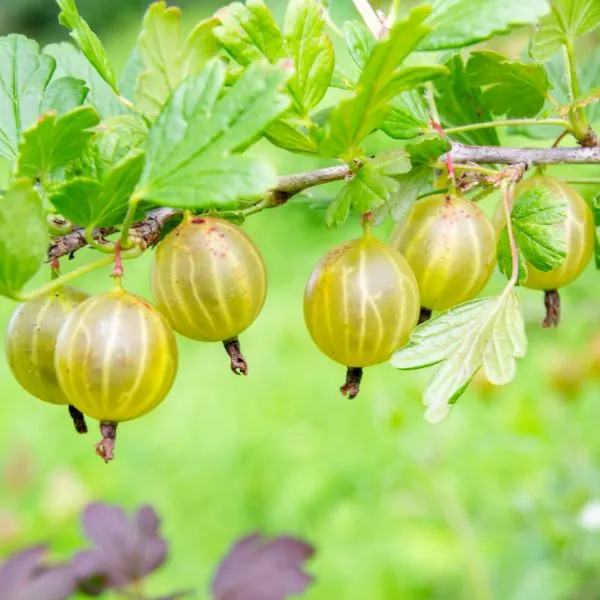
With their hardy character and enticing clusters of tart fruits, Gooseberries stand out against the cherry tree’s thick foliage and brilliant cherries.
Their companionship also has a practical function. Gooseberries are natural pollinators, attracting bees and other helpful insects that aid in cherry tree pollination, increasing fruit set and production. Furthermore, the thorny branches of the gooseberry operate as a natural deterrent, protecting the cherry tree from prospective trespassers and reducing the danger of injury.
To achieve maximum success, provide enough space between the two plants, providing good ventilation and avoiding the possibility of nutrient competition. Pruning procedures should be painstakingly adapted to each crop’s development patterns. Careful pest and disease monitoring is essential, as the shared environment may enhance vulnerability. The cherry tree and gooseberry union will thrive with proper care and maintenance, delighting the orchardist with a symphony of tastes and a harmonic interplay of textures.
23. Currants
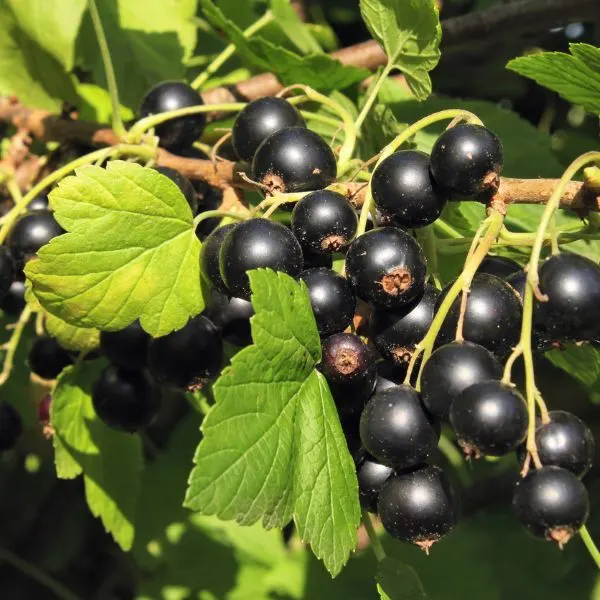
Currants dazzle with their vivid clusters of ruby-red or blackberries, adding to the overall visual appeal. Currants have several benefits aside from their aesthetic appeal. Their thick foliage is a protective barrier, sheltering cherry trees from direct sunlight, reducing water evaporation, retaining moisture, and controlling soil temperature.
Furthermore, currants attract helpful pollinators, facilitating productive pollination of cherry blooms and increasing overall fruit output. Their small root structure coexists peacefully with the larger roots of the cherry tree, reducing resource rivalry.
Maintaining adequate space between the two crops provides optimum air circulation and minimizes disease spread. Pruning cherry trees and currants on a regular basis helps improve light penetration and avoid overpopulation. Accept this dynamic combo and watch your garden flourish with a symphony of tastes and hues.
Bad companion plants for Cherry Trees
Grasses
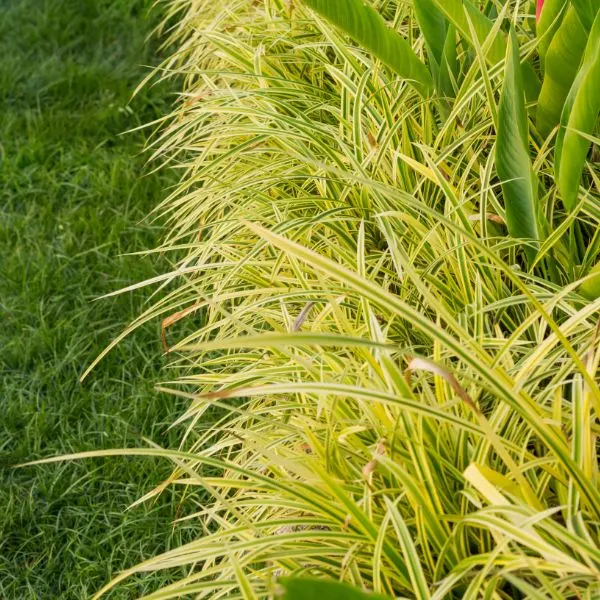
Planting Certain grasses with aggressive growth or shallow root systems near cherry trees can pose a slew of problems that hamper the tree’s growth and life. While grasses have their own distinct charm, their presence with cherry trees can have negative consequences.
Certain grasses grow aggressively, vying hard for water, nutrients, and sunlight. This ferocious rivalry can inhibit the cherry tree’s root growth and limit its access to vital supplies, compromising its overall health and production.
Furthermore, the short root systems of certain grasses can entangle with the roots of the cherry tree, potentially causing root injury or interference. This can jeopardize the tree’s stability and make it more susceptible to drought stress and nutritional deficits.
To achieve optimal growth, keep sufficient space between cherry trees and aggressive grasses, reducing their negative interactions. Regular weed control and keeping a clean zone around the tree’s base can help to offset these issues, enabling the cherry tree to thrive unhindered. Choose companion plants strategically to create a harmonious atmosphere that is beneficial to the cherry tree’s health.
Vegetables
Tomatoes (technically a fruit)
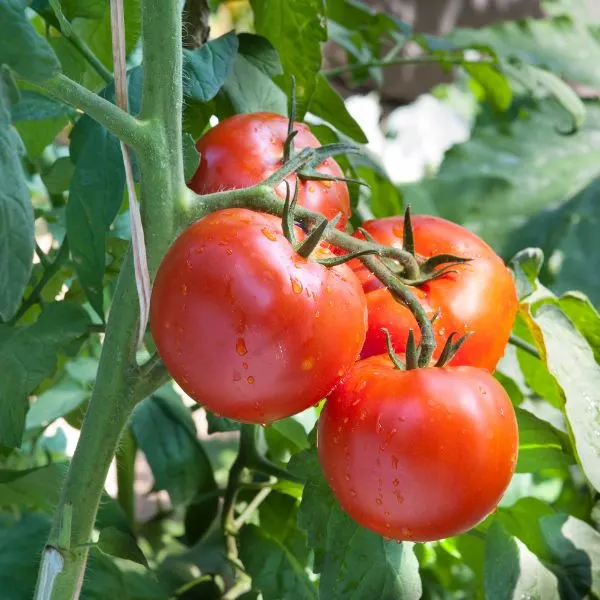
Intertwining tomato and cherry tree development may bring obstacles rather than benefits. While both crops grow on their own, their cohabitation might have negative consequences.
Planting tomatoes near cherry trees may enhance disease transmission risk. Both crops are vulnerable to a variety of fungal illnesses, including blight and leaf spot. Proximity can help these diseases spread, potentially endangering the health of both plants.
Furthermore, tomatoes demand a lot of light, frequently overshadowing the cherry tree and limiting its access to it. The thick foliage of tomato plants might obstruct air circulation and stunt the growth of the cherry tree.
Furthermore, tomato and cherry plants require various amounts of water. Tomatoes generally need more regular and constant watering, which may result in overwatering the cherry tree or an imbalance in moisture levels.
To avoid these issues, keep sufficient space between tomato and cherry trees to provide optimum ventilation, minimize disease spread, and allow each crop to thrive independently.
Potatoes
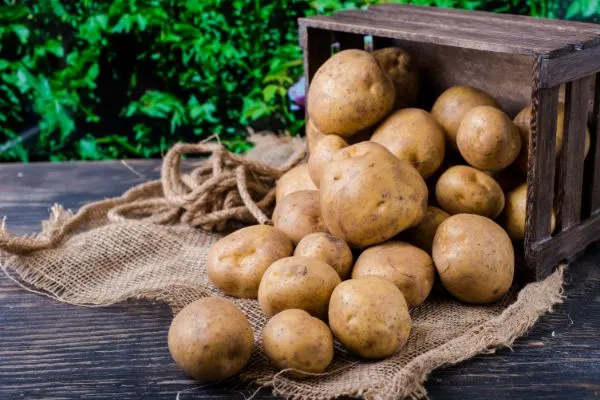
While pairing potatoes with cherry trees seems appealing, it might bring some difficulties and unpleasant results. When choosing this combination, being aware of the potential negative consequences
is critical.
Both crops have distinct growth patterns and nutritional requirements, which might lead to competition for scarce resources such as water and minerals. Potato plants’ rapid growth might shade the cherry tree, restricting sunshine availability and hampering its development.
Furthermore, potatoes are vulnerable to a variety of pests and diseases, including potato beetles and blight. Planting them next to cherry trees raises the chance of these problems spreading to the cherry tree, thus jeopardizing its health and fruit output.
Separating potatoes from cherry trees and providing them with their own growing space is suggested to preserve maximum development and health. This strategy decreases the likelihood of rivalry, insect infestations, and disease transfer, maintaining both crops’ general health and output.
Plants prone to diseases that can affect cherry trees
Planting disease-prone cherry tree companions offers a danger that might affect the vigor and output of your prized cherry trees. As we have mentioned earlier, plants that belong to this group include stone fruits such as plums and vegetables such as tomatoes and potatoes. These plants might be hosts for diseases, including bacterial canker, brown rot, and fungal infections, which could spread to vulnerable cherry trees.
Planting these disease-prone partners may damage the health and vigor of your cherry trees, resulting in decreased fruit output, weaker growth, and greater susceptibility to pests and infections. When choosing mates, it is essential to strike a cautious balance, avoiding those that might bring or contain illnesses harmful to cherry trees.
FAQs
What is the best natural fertilizer for cherry trees?
Plant turf grass beneath your cherry trees. Place a plastic landscaping cloth under the trees to assist in limiting or preventing larvae in dropped fruit from going into the soil and pupating for the winter. Fruit plants appreciate organic fertilizers with high nitrogen content. Organic nitrogen sources include blood, soybean, composted chicken manure, cottonseed, and feather meal.
Do cherry trees need to be planted next to each other?
For pollination and fruit set, just one sour cherry tree is required. Many sweet cherry cultivars are self-unfruitful because they cannot produce fruit from their own pollen. Cross-pollination is required for fruit development on these plants.
How do you make sure cherries don’t have worms?
Plant turf grass beneath your cherry trees. Place a plastic landscaping cloth under the trees to assist in limiting or preventing larvae in dropped fruit from going into the soil and pupating for the winter.
Conclusion
We have looked into the Good Companion plant and the Bad Companion plants for Cherry Trees and their effects when planted near Cherry Trees. These trees thrive in temperate settings and require well-draining soil. They also enjoy a sunny site with plenty of sunshine. Adequate watering is critical for maintaining a balance that prevents both drought stress and waterlogging.
Fertilization is essential for maximizing the development and quantity of cherry trees. These trees thrive from a well-balanced macronutrient mix that includes nitrogen, phosphorus, and potassium. Prior to planting, a soil test can provide specific nutrient requirements, allowing for targeted fertilizer treatments.
Regular trimming to maintain healthy branching and proper air circulation improves the tree’s overall health and promotes optimal fruit yield. Protecting cherry trees from common pests like aphids and cherry fruit bugs assures a bountiful crop.
Cherry trees reward producers with a profusion of delectable cherries, ready to be relished fresh or turned into mouthwatering culinary treats when painstaking attention to growth conditions and rigorous care is paid.
More fruits
